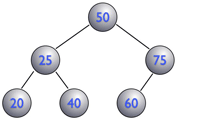I wanted to compare some of the various, famous sort algorithms, and I decided to write them using JavaScript. I implemented them by extending Array, and they are all listed below. I wouldn't recommend using any of these however, they are not optimized and the built-in sort() can beat all of them under almost all circumstances. These are presented here solely for educational purposes.
continue reading
Just another JavaScript custom object example. With this one I create a global object variable that is referenced by my class through its prototype. In this way the could also be referenced by other classes and this allows me to maintain some datas independently of the code.
continue reading

A binary search tree is a type of binary tree where the data in a node's left subtree is less than the node and the data in a node's right subtree is greater than (or equal to) the node, and the subtrees are also binary search trees. A binary search tree is a data structure upon which algorithms can be run. If a binary tree search was run, using a balanced binary search tree of course, the performance would be at most O(log n) since as you can see the pool of possible results is cut in half with each step (The tree must be balanced, my example does not properly balance when it adds. See:
AVL tree or
red-black tree).
continue reading
I was talking about JavaScript objects with someone at work today and I wanted a simple example to look at, but I couldn't find one quickly. So, I decided to write up a quick example and post it here for future reference. I'm also posting some links to helpful information on the web.
continue reading
This is an extension that I have been using to parse URL search strings and hash codes. I thought that I would share it with the world, and if the world has a better method I hope that someone shares it with me.
continue reading
Sometimes it is nice to make a SmartForm more dynamic, especially since they can be a pain to maintain for complicated labels. In cases like this my colleagues in Germany have developed this method to apply SAP classification to SmartForms.
The first step is to create the desired characteristics. Follow these steps for each characteristic that is required.
- CT04 "Characteristics Management"
- Create a new characteristic (ZLE_MYLABEL_FIELD1)
- Basic Data: Data Type (Character Format), No. of chars (1)
- Descriptions: EN (My field), DE (Meine feld)
- Values: Char Value (1, 2, 3, …) Description (This is my field)
- Restrictions: Class type ZLW
- Save
Continued after the break...
continue reading
The establishment of Rus was a complicated affair, whose exact origins are still not entirely clear. According to the “Primary Chronicle” a Varangian, or Scandinavian Viking, name Rurik established Novgorod at the behest of the indigenous Slavs who could not rule themselves. Rurik’s successor, Oleg, took control of portions of the Dnieper River and eventually moved the capitol to Kiev in 882 CE. Oleg unified numerous Slavic tribes, and is considered to be the first ruler of Kievan Rus.
continue reading
Modern day Turkey is located in an area that was the heart of the Ottoman Empire; one of the largest Islamic empires in history. Yet today, Turkey is one of the most western style Islamic nations, and is even a candidate for entrance into the European Union. Though it's history is relatively short, the series of events that led up to the Republic of Turkey's westernized state is quite complicated. Through that history, Turkey has been able to balance the demands of maintaining a republic with Islamic traditions.
It would seem as if modern situations in the Middle East mirror aspects of Turkey's history. And, these recent events in world history may tempt Americans to believe that this transformation must have been induced by some sort of allied nation-building efforts after the world wars.
1 Though the United States' history influenced the transformation, it was then promulgated by the Turks.
continue reading
 A binary search tree is a type of binary tree where the data in a node's left subtree is less than the node and the data in a node's right subtree is greater than (or equal to) the node, and the subtrees are also binary search trees. A binary search tree is a data structure upon which algorithms can be run. If a binary tree search was run, using a balanced binary search tree of course, the performance would be at most O(log n) since as you can see the pool of possible results is cut in half with each step (The tree must be balanced, my example does not properly balance when it adds. See: AVL tree or red-black tree).
A binary search tree is a type of binary tree where the data in a node's left subtree is less than the node and the data in a node's right subtree is greater than (or equal to) the node, and the subtrees are also binary search trees. A binary search tree is a data structure upon which algorithms can be run. If a binary tree search was run, using a balanced binary search tree of course, the performance would be at most O(log n) since as you can see the pool of possible results is cut in half with each step (The tree must be balanced, my example does not properly balance when it adds. See: AVL tree or red-black tree).